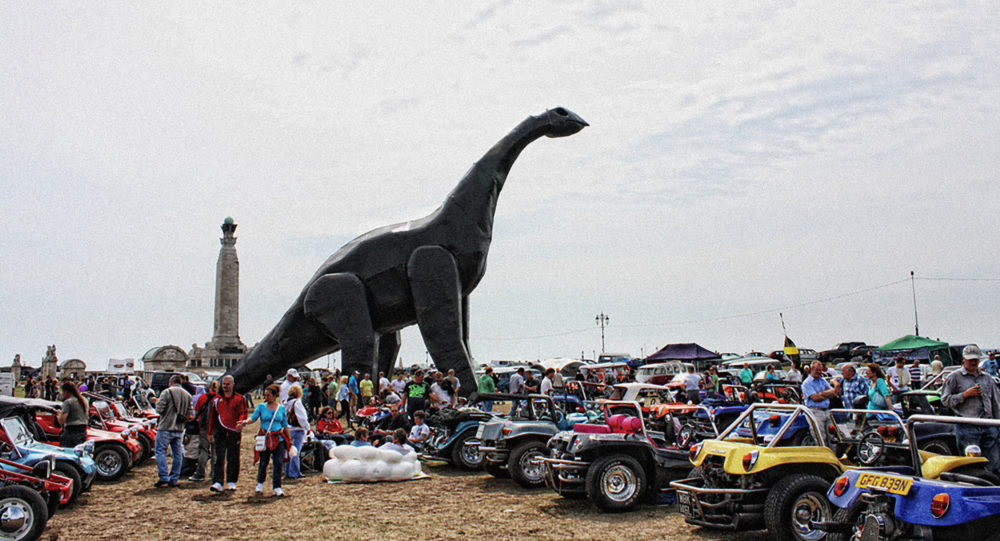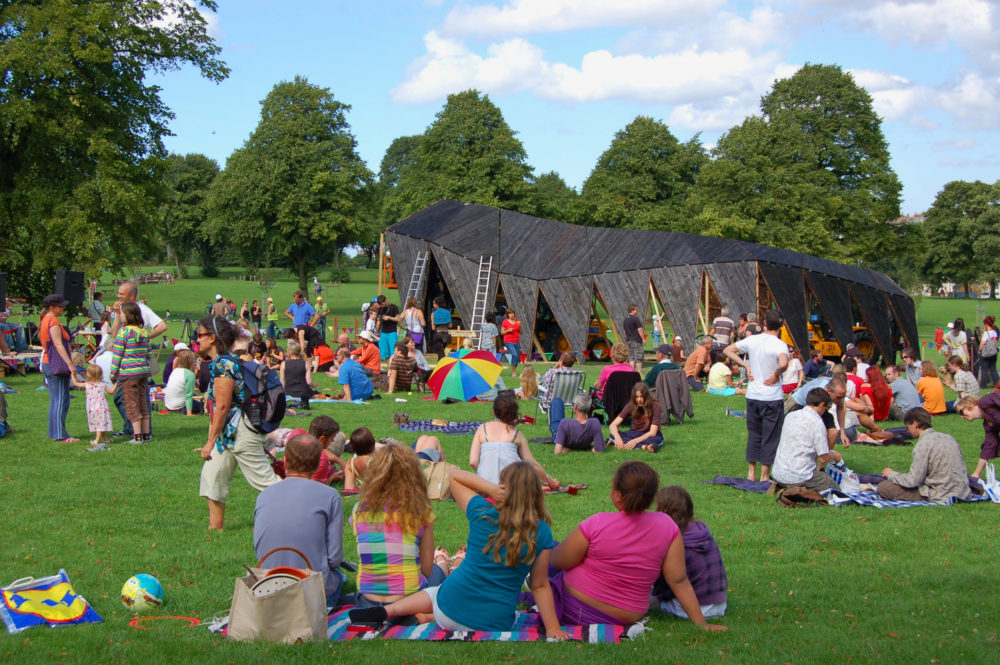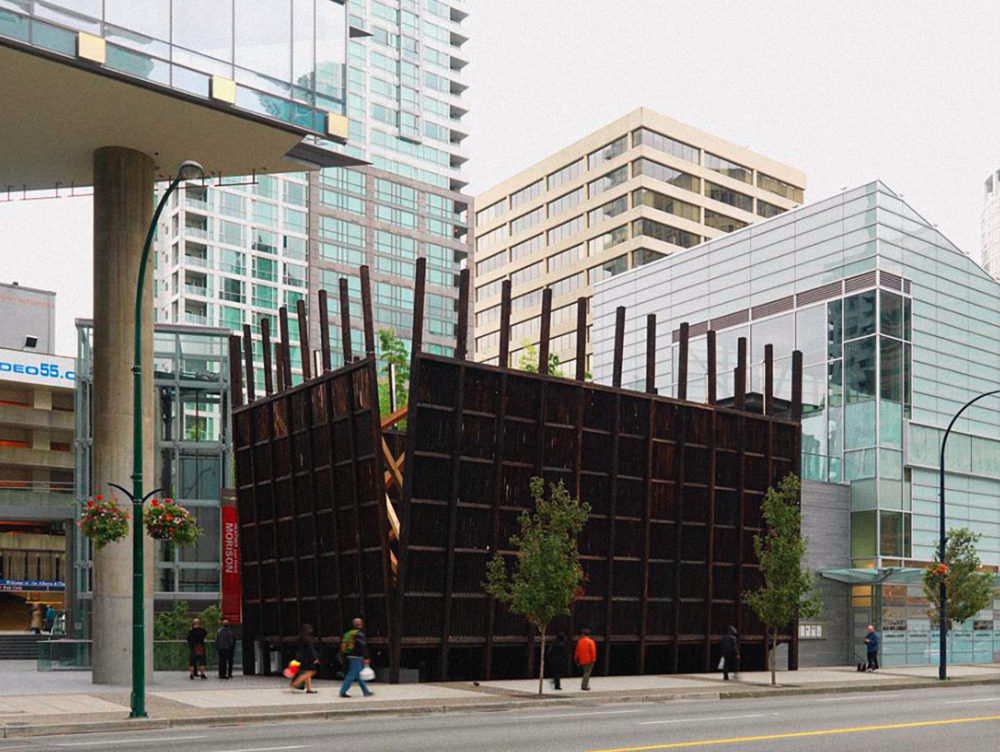This is an edited version of a paper presented by Claire Doherty at a conference called ‘Destroyed public artworks: a critical reflection’ organised by Jes Fernie in partnership with Firstsite, University of Essex, and the RCA in 2011. Doherty discusses how destruction of public artworks is viewed within the contemporary commissioning process; how fear of failure can stunt ambition; and how the emotional impact of destruction can effect curators and artists. She questions the definition of ‘success’ of a public artwork, and proposes that these works become a space of agitation and dissent which can be changed through a relationship with the public.
In gathering here today, are we undertaking the contemporary art equivalent of rubber-necking? Slowing down to gape at the carnage of public artworks that have been destroyed: their carcasses bearing resemblance to a victim of destruction.
The contorted remains of Heather and Ivan Morisons’ Luna Park (2010) and the car destroyed by a bomb in a Baghdad street (which is the symbolic heart of Jeremy Deller’s It is what it is, 2009), bear a formal resemblance to one another – you cannot help but find yourself guiltily intrigued by their post-apocalyptic associations. The emotive charge of them as objects relies upon, what Elaine Scarry has referred to, as the ways in which the art object is a prosthetic for the body.1 Our fascination with them is particularly powerful because they reperesent the antithesis of the process of making. Every one of us here is engaged in the potential of making: whether artists, curators, commissioners or funders, we are committed to that moment of becoming – hurtling towards the unveiling, the opening, the launch.

Artist Daniel Buren once wrote of the function of the studio space as, ‘the first frame, the first limit, upon which all subsequent frames/limits will depend.’2 We acknowledge now of course that the limits of studio, museum, gallery, off-site, outside and public are blurred and contested, but, all the same, our profession and public expectation still turns on the event of the launch – at which the work is considered to be in its most pure and resonant form. The messing up of this stable and fixed moment is what we are dealing with here today.
An underlying fear permeates our work as artists, curators, commissioners and funders: a fear which has fuelled the discourses and practices of public art in all its forms for decades. If we are in the business of fulfilling particular dreams and aspirations – making real certain forms, we do so mindful that we might fail. But failure in the public realm is far more visceral and violent than the indignity of a bad review or the rejection of an apathetic audience.
We might consider the drama of destruction as a kind of aesthetic in its own right: from the jaws of the digger biting into a sculptural form of Rachel Whiteread’s House, to the winches and cranes dismantling a work, to the daubs of paint on proud statues and the charred remains of Raymond Mason’s Forward from an arson attack in 2003, to the Morison’s most recent burnt out Ultrasaurous.

This amounts, as Maev Kennedy recently suggested in The Guardian, to a, ‘dismal national inventory of much abused art’3: the dead generals on war memorials now missing fingers or swords, the 12 metre Wicker Man in Somerset torched within weeks of completion, and the Milton Keynes cows repeatedly attacked, occasionally kidnapped and held to ransom, not to mention the empty plinths and scars in places where public artworks used to stand.
These structures and residues are made all the more potent because of the media furore which often surround the works’ destruction or removal, but before we explore how we might rethink this process as a productive rather than a destructive reaction – we should acknowledge the very real emotional toll implicit here. I want to share with you a memory which highlights the personal implications of public art destruction.

In July 2009, Heather and Ivan Morison installed a new work in a park in south Bristol. The Black Cloud was a temporary pavilion-like shelter, the design of which was informed by vernacular architecture built to withstand extreme environmental conditions, with the Yakisugi treatment of the timbers creating a scorched, protective shield. It was constructed through a community barnraising – a day in which people came together to offer their skills and knowledge. Acting as a shelter and meeting point, the structure was also open for free to local residents, groups and organisations throughout its four month duration in the park.
At around 6.00am, some four weeks after the barnraising, I awoke to the sound of a series of crashes accompanied by angry shouts. The proximity of the Black Cloud to my house was unprecedented. I’d never actually slept within hearing distance of a commissioned work; my subconscious had become attuned to listening out for disturbance. Within a few seconds, I was out of bed and saw three figures descending on the Black Cloud with crowbars. It was a shocking, physically immobilising sight which went on for a period of ten minutes or so, with various residents shouting at them to stop – before the police showed up. In terms of damage, the structure was repaired, and in many ways instilled a greater sense of ownership amongst neighbours and new users.
But firstly, I want to register that emotional impact – that sense of rejection, of futility, that sense of failure – that somehow, despite the success of the barnraising and associated events, that this single act of destruction and violence – seemed to indicate a failure to me.
But the fear of failure (of that kind of public rejection) can lead us down an unhelpful path. The knee-jerk reaction to this kind of event is to create systems that mitigate against destruction and vandalism. How many of us have become experts in anti-vandal paints and robust materials, or have developed sophisticated methods of embedding a work through community engagement?
Certainly such tactics go some way to guard against the total destruction or removal of work. Sophie Hope and Cameron Cartiere in their production of the Manifesto of Possibilities, for example, have examined the multiple agendas at play in the process of public art commissioning and how some of these desires, aspirations and expectations might be better served through consultation, collaboration and a shared set of objectives and understanding of process.4
Given that today is a critical reflection on destroyed public artworks, perhaps we could go beyond the emotional implications of destruction and beyond best practice in mitigating the circumstances of destruction.
It seems to me that the essential problem with asking how we can protect public artworks or build ownership for public artworks, is that we don’t question whether this is something we should be doing. And if we unsettle that idea of protection, that might also lead us to question what we understand as successful public artworks? Do we read acts of destruction or removal as failures?
There is a disparity that lies at the heart of public art commissioning: a disparity between the positive affirmation of place (as advocated in cultural policy documents, consultancy briefs for the commissioning of artworks within the context of regeneration and the curatorial rhetoric surrounding place-based exhibitions and projects) versus the conflictual lived experience of place proposed by geographers such as Doreen Massey and Tim Cresswell and archaeologists such as Mike Pearson and Michael Shanks.
In affirmative strategies and policies, place is promoted as an existing, stable (perhaps historically embedded) entity to which artists were invited to respond, or as something which could be rebranded through commissioning, whereby location (and consequently place-based artworks) are aligned with cultural tourism.
By contrast, in the academic sphere, Doreen Massey has suggested that the task is to ‘uproot “space” from that constellation of concepts in which it has unquestioningly so often been embedded (stasis; closure; representation), and to settle it among another set of ideas (heterogeneity; relationality … liveliness indeed) where it releases a more challenging political landscape.’5
The contradictory pull in art commissioning is between the desire for art to contribute to place identity as a stable, knowable (perhaps improved) place and the potential for art to contribute to a state of flux, an event-in-process.
The controversy surrounding the destruction or removal of works – reveals the complex contestation of public space – a term which in itself is deeply contested.
In my opinion, the works which successfully capture the dynamic, progressive notion of place are those which are situation-responsive but also situation-producing and contest the power dynamics of the context in which they operate and refrain from indulging in a literal reading of the specifics of location. If we take Miwon Kwon’s notion of the wrong place, the avant-garde struggle, as she suggests, as a kind of spatial politics, ‘to pressure the definition and legitimation of art by locating it elsewhere, in places other than where it belongs’.6 If art locates itself in places other than where it belongs, does this necessarily result in conflict, making vandalism, rejection and destruction on some level almost inevitable?
It seems to me that we can discern a capacity to unsettle existing perceptions of place through strategies of displacement, interruption, new gathering points and dispersal which create new situations in place. Perhaps we need to reconcile ourselves and funders to the fact that it is not public art’s task to settle conflict. But rather to enter collective memory, to contribute to place as an event-in-progress.
In the case of the Black Cloud, we can see that the work both contributes to and produces a contested public space. In this case, the work was not commissioned as part of a redevelopment or regeneration scheme and therefore, to a certain extent, could evolve as a provocation which contested the power dynamics of the park in South Bristol.
So if the first observation is to consider how the act of illicit or sanctioned destruction is part of the artwork’s lived experience, this leads us to consider the temporal limits of public art. In an important article in 1989, Patricia Phillips suggests, ‘Public art is potentially enriched and amended by a multiplicity of philosophical, political, and civic issues. It need not seek some common demoninator or express some common good to be public, but it can provide a visual language to express and explore the dynamic temporal conditions of the collective….It requires a commitment to experimentation – to the belief that public art and public life are not fixed.’7
We might think of it, as Phillips has suggested, as being about the idea of the commons – a space of dissent as well as democracy.

Finally, we might begin to think about this act of making not as engendering a finished, pure, complete work, but beginning something that is about to unfold through agitation, through contestation that will be changed through the ways in which people come to experience it. I conclude with an image of the Morison’s most recent piece, Plaza (2010), in Vancouver, as a suggestion of a space which has clear visual association with the profound destruction of 9/11 but also acts as a meeting point, a gathering point – as a commons, a place which is unknowable, in which contestation and agitation may occur.
